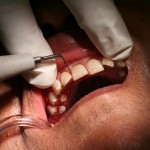
Periodontitis is a chronic inflammatory disease resulting from interaction between bacterial infection and the host response that is modified by behavioural and systemic risk factors. Treatment involved effective oral hygiene measures and scaling and root planing typically delivered in a stepwise approach. After successful treatment (no pockets ≥4 mm with bleeding on probing [ BoP] ) patients are placed in supportive periodontal care.
The aim of this systematic review was to assess whether repeating subgingival instrumentation in combination with adjunctive therapies (other than antimicrobials) might provide a significant benefit in terms of pocket closure, probing pocket depth (PPD) reduction or clinical attachment level (CAL) gain in patients during supportive periodontal care (SPC) with residual/relapsing pockets.
Methods
A protocol was registered with the PROSPERO database. Searches were conducted in the Cochrane databases, Embase, Medline, and Web of Science databases. This was supplemented by searches in Proquest Disertation and Thesis, opensigle.inist.fr, Clinicatrials.gov and hand searches of the journals, journal of Clinical Periodontology, Journal of Periodontology, Journal of Dental Research, Journal of Periodontal Research, Journal of investigative and clinical dentistry for the last two years. Randomized controlled trials (RCTs) and prospective controlled clinical trials (CCTs) with a minimum follow-up of 3 months and published in English, Italian, Greek, Turkish, German or Spanish were considered. The studies involved adult periodontitis patients who had completed active periodontal treatment 3 months previously presenting with residual pockets (PPD > 4 mm) during supportive periodontal care (SPC). The primary outcomes were the proportion or number of pockets closed (defined as PPD <5 mm and no BoP); changes in PPD, and changes in CAL. Two reviewers independently screened and selected studies and extracted data. One reviewer assessed study quality using the Cochrane risk-of-bias tool for randomised trials (RoB 2) and the ROBINS-I tool for CCTs with 40% of studies being cross-checked by a second reviewer. Primary outcomes were summarised using Mean values and 95% confidence intervals (CI) with meta-analyses of weighted mean differences, with 95%CI were performed when ≥3 studies assessed the same characteristics.
Results
- 12 studies (10 RCTS, 2 CCTs) involving a total of 732 patients were included
- 5 studies assessed adjunctive photodynamic therapy (PDT), 5 evaluated different antiseptic, one, systemic probiotics, and one daily supplementation of vitamin D and calcium.
- All studies were conducted in a university setting with 7 receiving industry funding.
- Level of active periodontal therapy (APT) previously provided was variably described.
- Two of the 10 RCTs were considered to be at low risk of bias and 8 to have some concerns.
- Both of the CCTs were considered to have a serious risk of bias.
- 5 studies considered photodynamic therapy with 3 contributing to a meta-analysis which showed no difference in PPD or CAL with adjunctive PDT use (see table)
| Photodynamic therapy | PPD (95%CI) | CAL (95%CI) |
| 3 months | 0.07 (−0.29 to 0.42) | −0.03 (−0.46 to 0.39) |
| 6 months | −0.09 (−0.70 to 0.52) | −0.18 (−0.57 to 0.22) |
- Of the other 2 studies one showed no benefit in favour of PDT and the other study a PPD reduction and CAL gain with PDT use at 6 months.
- 5 studies considered different antiseptics with no clinical benefits being demonstrated.
- 1 study (20 patients) demonstrated improvements in PPD and CAL with probiotic lozenges
- 1 study (51 patients) of vitamin D and calcium supplementation showed better PPD and attachment levels at 3 and 6 months
Conclusions
The authors concluded: –
…antiseptics did not provide significant benefits, one study on probiotics and one on the use of vitamin D and calcium supplementation showed significant improvements in periodontal parameters. There is currently insufficient/poor evidence to determine the efficacy of adjunctive strategies (other than antimicrobials) to improve the outcomes of SPC in case of residual/relapsing pockets.
Comments
The authors have preregistered a protocol and undertaken a search in a good range of databases. The questions they have chosen to address is specific to the use of adjunctive therapies in patients during supportive periodontal care (SPC) with residual/relapsing pockets. Consequently, the number of available studies is small with 8 of the studies also involving fewer than 50 patients. As the reviewers note a number of adjunctive therapies have been tested as part of initial periodontal treatment but not as an element of SPC. Although it is worth highlighting that many of studies of these adjunctive studies involve a limited number of patients and have quality issues. Additional high quality well reported studies using common outcomes are needed to assess the most effective adjunctive therapies and their implementation to improve the management of the common public health problem. As the authors highlight there is also a need for studies to be undertaken in a primary care environment.
Links
Primary Paper
Calciolari E, Ercal P, Dourou M, Akcali A, Tagliaferri S, Donos N. The efficacy of adjunctive periodontal therapies during supportive periodontal care in patients with residual pockets. A systematic review and meta-analysis. J Periodontal Res. 2022 Aug;57(4):671-689. doi: 10.1111/jre.13001. Epub 2022 May 17. PMID: 35579234.
Other references
Dental Elf – 27th Nov 2022
Photodynamic therapy as an adjunct to non-surgical periodontal treatment
Dental Elf – 8th Jul 2020
Antiseptics as adjuncts to nonsurgical periodontal treatment
Dental Elf – 27th Mar 2018
Dental Elf – 6th Jul 2018
Dental Elf – 27th May 2022
Dietary omega-3 fatty acids as an adjunct to non-surgical periodontal treatment
